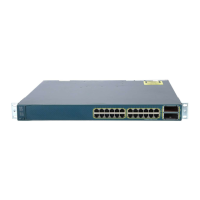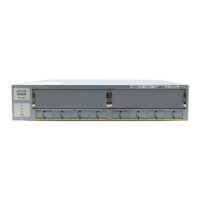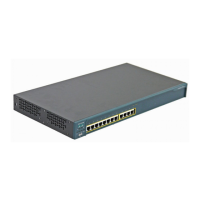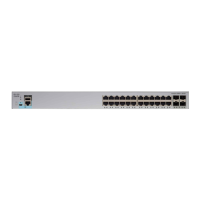13-15
Catalyst 3750 Switch Software Configuration Guide
78-16180-02
Chapter 13 Configuring VLANs
Configuring Extended-Range VLANs
To delete an extended-range VLAN, use the no vlan vlan-id global configuration command.
The procedure for assigning static-access ports to an extended-range VLAN is the same as for
normal-range VLANs. See the “Assigning Static-Access Ports to a VLAN” section on page 13-11.
This example shows how to create a new extended-range VLAN with all default characteristics, enter
config-vlan mode, and save the new VLAN in the switch startup configuration file:
Switch(config)# vtp mode transparent
Switch(config)# vlan 2000
Switch(config-vlan)# end
Switch# copy running-config startup config
Creating an Extended-Range VLAN with an Internal VLAN ID
If you enter an extended-range VLAN ID that is already assigned to an internal VLAN, an error message
is generated, and the extended-range VLAN is rejected. To manually free an internal VLAN ID, you
must temporarily shut down the routed port that is using the internal VLAN ID.
Beginning in privileged EXEC mode, follow these steps to release a VLAN ID that is assigned to an
internal VLAN and to create an extended-range VLAN with that ID:
Step 7
show vlan id vlan-id Verify that the VLAN has been created.
Step 8
copy running-config startup config Save your entries in the switch startup configuration file. To save
extended-range VLAN configurations, you need to save the VTP
transparent mode configuration and the extended-range VLAN
configuration in the switch startup configuration file. Otherwise, if the
switch resets, it will default to VTP server mode, and the extended-range
VLAN IDs will not be saved.
Command Purpose
Command Purpose
Step 1
show vlan internal usage Display the VLAN IDs being used internally by the switch. If the VLAN
ID that you want to use is an internal VLAN, the display shows the routed
port that is using the VLAN ID. Enter that port number in Step 3.
Step 2
configure terminal Enter global configuration mode.
Step 3
interface interface-id Enter the interface ID for the routed port that is using the VLAN ID.
Step 4
shutdown Shut down the port to free the internal VLAN ID.
Step 5
exit Return to global configuration mode.
Step 6
vtp mode transparent Set the VTP mode to transparent for creating extended-range VLANs.
Step 7
vlan vlan-id Enter the new extended-range VLAN ID, and enter config-vlan mode.
Step 8
exit Exit from config-vlan mode, and return to global configuration mode.
Step 9
interface interface-id Enter the interface ID for the routed port that you shut down in Step 4.
Step 10
no shutdown Re-enable the routed port. It will be assigned a new internal VLAN ID.
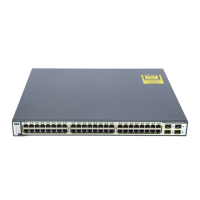
